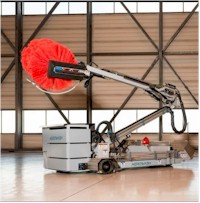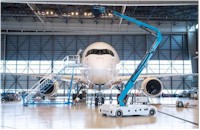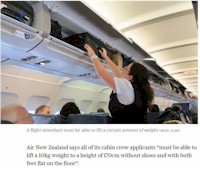|
More on the female flight attendants started in The cabin crew industry has undergone a raft of changes in its history, from a dizzying array of uniforms to an evolution of the exact specifications applicants must meet. A 1936 New York Times article described the ideal air hostess as "petite; weight 100 to 118 pounds; height 5 feet to 5 feet 4 inches; age 20 to 26 years. Add to that the rigid physical examination each must undergo four times every year, and you are assured of "the bloom that goes with perfect health." Three decades later, in 1966, a New York Times classified ad for stewardesses at Eastern Air Lines listed these requirements: "A high school graduate, single (widows and divorcees with no children considered), 20 years of age (girls 19 1/2 may apply for future consideration). 5'2" but no more than 5'9", weight 105 to 135 in proportion to height and have at least 20/40 vision without glasses." |
|
Current Common Requirements (2017)
Air New Zealand says all of its cabin crew applicants "must be able to lift 10kg (22 lbs) weight to a height of 170 cm (5' 6") without shoes and with both feet flat on the floor". |
|
Weight and body mass index (BMI) Airlines generally require flight attendants to be “in proportion to your height”. What might be considered a “healthy weight” may be determined by your body mass index, as seems to be the case with Czech Airlines. “BMI is used to calculate weight – one’s body weight in kilograms is divided by the square of one’s body height in metres. BMI = body weight (kg) divided by square of height (m). A BMI = 19-24.9 is considered satisfactory”, the airline states. In 2016, Air India warned 600 of its 3,500 crew to lose weight within six months or risk being taken off flights. The airline announced plans to remove nearly 130 workers from cabin crew duty because their BMI levels remained above the prescribed limit. The airline said that the “normal” BMI for an air hostess is between 18 and 22, “overweight” between 22 and 27, and “obese” for a value above 27. For male attendants the brackets were 18 to 25, 25 to 30, and above. The NHS says a “healthy” BMI is between 18.5 and 24.9. (Source: Daily Telegraph) More information at: www.telegraph.co.uk |



